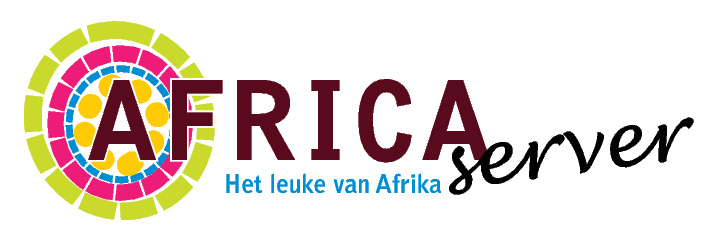Zaterdag 10 Mei 2014

Apartheid and After - 13 Zuid-Afrikaanse fotografen
Laten zien hoezeer het recente verleden de waarneming van nu kleurt. Dat lijkt de rode draad te zijn die het werk van de dertien deelnemende fotografen na 1990 verbindt. Hoe spectaculair de verschillende selecties ook zijn, het is fotografie met een dubbele agenda - maar dan wel een in de positieve zin van het woord. Hier wordt vanuit de kennis van toen nauwkeurig scherp gesteld op het heden - en andersom. Paul Alberts, Hugh Exton, David Goldblatt, Pieter Hugo, Santu Mofokeng, Sabelo Mlangeni, Zanele Muholi, Daniel Naudé, Jo Ractliffe, Mikhael Subotzky, Guy Tillim, Paul Weinberg, Graeme Williams en de Market Photo Workshop in Johannesburg.

Multi-media installation: Richard Mosse - The Enclave
Foam presents The Enclave by Richard Mosse, a major multi-media installation which represented Ireland at the 55th International Art Exhibition - La Biennale di Venezia. The installation, consisting of six large screens, represents the conflict situation in Congo and was shot with infrared film that was designed for camouflage detection resulting in vibrant, psychedelic magenta coloured sites of the jungle war zone. Besides the film installation, related photo works are shown.
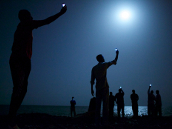
World Presss Photo
Start van de lange wereldtour van de internationale persfotowedstrijd. Ruim 150 indrukwekkende persfoto’s van 53 prijswinnaars, in negen categorieën. De bezoeker maakt in de kerk een fotografische wereldreis door alle continenten en langs de meest uiteenlopende thema’s en historische gebeurtenissen uit 2013. De jaarwinnaar is John Stanmeyer, USA, met zijn foto Signal, gemaakt voor National Geographic. Dit mystieke beeld toont hoe Afrikaanse migranten op een strand bij de stad Djibouti met hun telefoons trachten signaal op te vangen uit buurland Somalië. Ook andere foto's met Afrikaanse onderwerpen zijn in de prijzen gevallen.

African Masterpieces - The Story of the Kingdom of Ife
The first exhibition to focus on the art of Ife, an ancient city in modern day Nigeria. The artists of Ife made sculptures from metal, stone and terracotta that have placed the region on the map in terms of world art history. The exhibition displays some of the world's most sophisticated historical art works – more than 100 sculptures of metal, stone and terracotta from the 12th to 16th centuries tell the story of the African civilisation of Ife, ancestors of the Yoruba, one of the largest ethnic groups of modern day Nigeria. The exhibition has previously been on view in the USA, Great Britain and Spain.
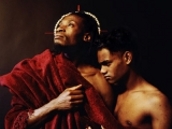
Traces of Ecstasy - Rotimi Fani-Kayode (1955-1989)
A provocative, multilayered photographic retrospective. This profoundly personal and political exploration of complex notions of desire, diaspora, and spirituality, imaginatively interprets the boundaries between spiritual and erotic fantasy, cultural and sexual difference. A seminal figure in 1980s black British and African contemporary art, Fani-Kayode’s timeless photographic tableaux make the black male body the focal point of enquiry. Ancestral rituals and a provocative, multi-layered symbolism fuse with archetypal motifs from European and African cultures and subcultures - inspired by what Yoruba priests call ‘the technique of ecstasy’.
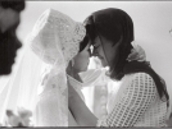
A Nomad’s Harvest - a retrospective of photographs by George Hallett
Aspects of a career spanning more than half a century. The works on show are from the collection of George Hallett and augmented by a comprehensive display of biographical information, as well as, book and record covers designed by Hallett. Included on this exhibition, amongst others, are recognisable images of Hout Bay, District Six, the Bo-Kaap, as well as immigrants and gypsies in London. His series of portraits of exiled South African writers, artists and musicians in London and France are of special interest.

Vrouwen van het water - foto's van Angèle Etoundi Essamba
In deze tentoonstelling nemen we u mee naar Ganvié, een vissersdorp aan de zuidkust van het West-Afrikaanse land Benin. Kenmerkend voor het dorp zijn de woningen op palen, zwevend boven het water van een lagune, het meer van Nokoué. Fotografe Angèle Etoundi Essamba (Cameroun) bezocht Ganvié de afgelopen jaren meerdere keren, ging in gesprek met de vrouwen en volgde hen in het ritme van hun dagelijks leven, waarin water zo’n cruciale rol speelt. Want terwijl de bewoners, de Toffinou, volledig omringd worden door water, is drinkwater schaars. De vrouwen spelen een belangrijke rol in het watermanagement, beheren de grote vaten met drinkwater en zijn uiterst zuinig in het gebruik ervan.
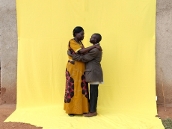
Rwanda 20 Years - photographs by Pieter Hugo and Lana Mesić
On April 7th 2014, it will have been 20 years since the genocide started in Rwanda. The international community didn’t take action and the country was obliged to find justice on its own. 20 years later some of the survivors say they have forgiven the people who killed their family members. Creative Court wonders: What could forgiveness be in a genocide context and how would one visualize it? South African photographer Pieter Hugo and Dutch photographer Lana Mesić went to Butare, in the south of Rwanda, in an attempt to find out. Part of a series of exhibtiions and events.
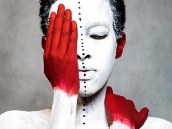
The Divine Comedy: Heaven, Hell, Purgatory revisited by Contemporary African Artists
On three floors, one each devoted to heaven, hell and purgatory, works of over 50 artists from all over Africa in a variety of media are presented: paintings, photographs, sculptures, videos, installations and performances. Against the background of the many Africa-related exhibitions of the past years, the MMK perceives the need to investigate the significance of African art not only in the post-colonial context but also with regard to aesthetics. The exhibition concept transports the universal issues of the Divine Comedy, an incunable of European literature, into the present and places them in a transnational contemporary context.

Ibrahim El-Salahi - Selected Works 1962-2010
Skoto Gallery is pleased to present Selected Works 1962-2010 by Ibrahim El Salahi, an exhibition of dynamic drawings and paintings by the Sudanese-born artist. This will be his second solo show at the gallery and the first U.S presentation of his work since his highly-acclaimed retrospective at the Tate Modern, London in 2013.
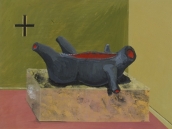
Facing Form - vorm als verbinding ...
De beelden van Hans van der Ham zijn in de eerste plaats vorm, ze bedekken en verhullen, en roepen vragen op over de mens achter het masker, verscholen in vorm. Victor Ekpuk tekent nieuwe vormen op basis van oude Afrikaanse symbolen en ontwikkelt zo een nieuwe unieke universele vormtaal. Obinna Makata maakt collages van Afrikaanse stof en inkt. De vormen zijn metaforen voor de mens, getekend op een elementaire manier. Zijn werk noemt hij wel “Broken pieces of African culture”. De tekeningen van Uche Uzorka zijn een oefening in hoe lijnen vorm worden, waarbij je de lijnen als mensen kunt zien. “Human beings who connect, disconnect and reconnect.”

Mufuki - Solo Exhibition
Mufuki Mukuna studied monumental painting at the Royal Academy of Fine Arts in Brussels. His work concentrates on exploring relentlessly the boundaries of figurative painting. In each of his paintings, Mufuki invites us to witness clashes, changes of life or attitudes boiled down to simply "human behaviour" with dark shades or a night time feel inspired by Motion Pictures, urban environments, Occidental or African elements. An abundance of images that highlight the loneliness human beings are often subjet to. A spiritual, raw and lively approach to painting, sometimes painful or even fascinating.
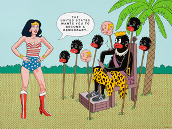
Such, Such were the joys - drawings and paintings by Anton Kannemeyer
As South Africa moves into its 20th year of democracy, Kannemeyer continues to explode the idea of the 'rainbow nation' through the incisive satire with which he first eviscerated apartheid's officials and bureaucrats. New works will be included in the exhibition. These are often in the genre of extreme satire which can simplistically be described as 'politically incorrect', a term Kannemeyer regards as reductive. Transgression of our strong beliefs and the sacred stereotypes of race, sex and politics is unavoidable in order for satire to be both critical and playful about themes that often abound in contradictions that we choose not to see.
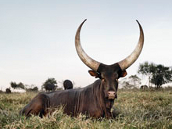
Sightings if the Sacred: Cattle in India, Uganda and Madagascar - photographs by Daniel Naudé
For the past two years Naudé has focused on photographing cattle in societies where these animals are revered and venerated. This is a position far removed from the Western world where they are mostly seen as productive sources of milk, meat and skins. Naudé first photographed the Ankole cattle in Uganda, renowned for their majestic horns which ideally curve out and then inward. In Madagascar, the distinctive Zebu cattle form part of the Bara people's cosmology and ancestor worship. In India, the Brahmin culture sees cows, along with all other life forms, as manifestations of god.

The Needle and the Damage Done - prints by Diane Victor
For Diane Victor, making art ‘provides a way of working through troublesome images that lodge themselves persistently in her memory.’ The process is cathartic. The visual equivalent of psychoanalytic ‘talking cure’, Victor draws her subject matter from far and wide, pulling information from the media and personal encounters, transforming them into rich and heavily populated compositions, full-blown narratives employing her grotesque and characteristic iconography. In this exhibition, one sees Victor still pre-occupied with ‘the big “catholic” sins – greed, lust, envy and excess.

Running - photographs by Thabiso Sekgala
Photographic exhibition bringing together three series: ‘Running Amman’, ‘Running Bulawayo’ and ‘Paradise’. Although shot in highly disparate places – the cities of Amman, Bulawayo and Berlin – all three series are viewed by Sekgala as part of a similar trajectory of movement, displacement, transition; each photograph displaying a veneer of calm, that may or may not be on the verge of catastrophe. Considering both the notion of running towards and away from, Sekgala confronts perceptions surrounding place, influenced by sentiments such as aspiration and assumption, and ultimately destabilises these.
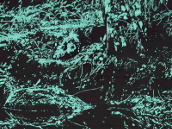
Deep Chine - paintings by Peter Eastman
For Eastman, his surroundings and environment have a profound influence on his work. Subjects are taken from lived interiors, cityscapes, studio views, family photographs and landscapes that are known to him. Eastman disassembles the image and reconstitutes it to form an entirely new picture which bears a vague semblance to the original, but for the viewer there is an uncanny familiarity and connection to the content, which is suffused with opaque moods and dreamlike memory. New shapes and forms emerge through the process of gradual fragmentation.
